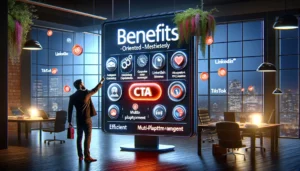CTA: 5 Innovative Strategies to Boost Your Ad Conversions

In the fast-paced world of digital advertising, the Call To Action (CTA) serves as the crucial tipping point between browsing and conversion. A well-crafted CTA can make all the difference in the effectiveness of your ads, guiding potential customers towards taking the desired action. This article delves into five innovative CTA strategies that can significantly boost your ad conversions, ensuring that your marketing efforts yield the best possible results.
Key Takeaways
- A/B Testing is essential for optimising ad elements and identifying the most effective strategies for conversion.
- Crafting a message that highlights benefits over features can better solve customer problems and fulfil their needs.
- Optimising CTAs for mobile users is critical, as a significant portion of online traffic is mobile.
- CTA placement should be strategic, ensuring visibility and relevance within the content, without appearing spammy or desperate.
- Employing persuasive language techniques, including storytelling, social proof, and scarcity, can enhance the compelling nature of CTAs.
1. CTA Strategy: A/B Testing
Embarking on the journey of A/B testing within your Google ads PPC campaigns is akin to unlocking a treasure trove of data-driven insights. Start with a hypothesis, such as the notion that tweaking the colour of your call-to-action (CTA) button could skyrocket click-through rates. Then, forge ahead by crafting two distinct versions: the original (A) and the modified (B). Utilise tools like Optimisely to simultaneously serve these variants to different audience segments.
The essence of A/B testing is not merely to amend underperforming ads but to embrace it as an ongoing ritual, even when your campaigns are hitting their stride.
By meticulously analysing the outcomes, you’ll discern which version captivates your audience more compellingly. This isn’t just about rectifying what doesn’t work; it’s about continuous enhancement, ensuring your Google Adwords PPC strategies remain at the pinnacle of efficiency. Agencies specialising in Google ads, such as Google advertising agencies, often conduct a thorough Google ads audit or PPC audit to refine their strategies.
Here’s a quick guide to implementing A/B testing:
- Initiate the A/B test from your ad platform’s interface.
- Select variables for testing, like ad creatives, copy, or target demographics.
- Follow the platform’s instructions to set up your test.
- Analyse the results to identify the more successful variation.
2. CTA Strategy: Benefits-Oriented Messaging
When crafting your call-to-action (CTA), it’s crucial to emphasise the benefits your audience will gain. Your CTA should resonate with their deepest needs, offering a clear solution or improvement to their current situation. For instance, if you’re an advertising agency specialising in Google Ads and PPC management, your CTA could highlight the ease of acquiring leads or the efficiency of your multi-platform approach, including LinkedIn, TikTok, and YouTube ads.
- Highlight the problem your service solves or the need it fulfils.
- Articulate the unique value proposition, making it irresistibly relevant.
- Incorporate elements of urgency, like limited-time offers, to motivate action.
By focusing on the benefits, you create a compelling reason for users to click through. This strategy not only increases the likelihood of conversion but also aligns with the principle of reciprocity—offering something genuinely helpful prompts further engagement with your brand.
3. CTA Strategy: Mobile Optimisation
In the realm of digital advertising, your mobile presence is paramount. As a PPC eCommerce agency expert, you know that a significant portion of your audience is tapping into your content via smartphones and tablets. Ensure your landing page is fully optimised for mobile devices; this is not just a recommendation, it’s a necessity. Test your landing pages across various devices and screen sizes to guarantee a seamless user experience.
Mobile speed is your number one priority. Users will abandon your site if it’s too slow, impacting your eCommerce ppc efforts negatively. Address technical issues such as slow loading times, unresponsive design, and dead links to enhance your site’s performance.
Here’s a quick checklist to ensure mobile optimisation:
- Use Google’s mobile-friendly testing tool for actionable tips.
- Adjust font sizes for readability on small screens.
- Compress images to speed up page loading.
- Streamline the conversion process by minimising form fields and providing clear instructions.
Remember, optimising for mobile isn’t just about aesthetics; it’s about creating a frictionless path to conversion. By focusing on these elements, you’re not just improving user experience—you’re directly influencing your ad conversions.
4. CTA Strategy: Strategic CTA Placement
Understanding the art of strategic CTA placement can significantly elevate your ad conversions. As a PPC agency, you know that the location of your call-to-action (CTA) can be just as critical as the message itself. Place CTAs strategically throughout your website and landing pages to ensure they are not only visible but also contextually relevant to your audience.
Consider the journey of your users and how they interact with your content. A London PPC agency might suggest placing a CTA at the end of a blog post or within the sidebar to capture the attention of engaged readers. Similarly, for mobile optimisation, ensure that CTAs are easily tappable and not hidden by awkward page layouts.
Here are some strategic placement tips:
- Above and below the fold for maximum exposure
- Within content that logically leads to conversions
- Balanced across the page to avoid overwhelming users
Effective PPC management involves testing and retesting CTA placements to find the sweet spot that resonates with your target audience. Remember, what works for one PPC ad agency may not work for another. Tailor your strategy to your unique audience and goals.
By placing your CTAs in locations where users are most likely to engage, you create opportunities for conversion that might otherwise be missed. This is the power of strategic placement—turning passive browsers into active participants in your marketing funnel.
5. CTA Strategy: Persuasive Language Techniques
Unlock the power of words to elevate your CTA’s effectiveness. Craft your message to resonate deeply with your audience’s desires and pain points. Use scarcity to create a sense of urgency—let them know what they stand to miss if they don’t act now. But remember, it’s not just about urgency; clarity is key. Your CTA should be a beacon, guiding users effortlessly towards the action you want them to take.
Your CTA is more than a button; it’s a promise of value. Ensure it’s a promise your audience can’t resist.
Employ a friendly tone to foster a connection. Phrases like “Let’s start a new project together” can transform a simple interaction into the beginning of a relationship. And don’t underestimate the power of personalisation; addressing your audience directly makes your message more compelling.
Here’s a quick checklist to refine your persuasive language:
- Use strong, action-oriented words
- Clearly articulate the benefits
- Align CTA colour with your brand or headline
- Keep it short and precise
- Position the CTA prominently
By integrating these techniques, you’ll craft CTAs that not only catch the eye but also capture the heart and mind, leading to higher conversion rates.
Conclusion
In the dynamic landscape of digital marketing, CTAs are the linchpin of ad conversions. As we’ve explored, innovative strategies such as A/B testing, benefits-oriented messaging, and strategic placement can significantly elevate your campaign’s performance. Remember, the goal is to make your CTAs irresistible, guiding users towards taking action effortlessly. By implementing these cutting-edge techniques, you’re not just calling for action; you’re creating a pathway for conversion success. Stay ahead of the curve, test rigorously, and always aim to deliver value that resonates with your audience. The power of a well-crafted CTA cannot be overstated—it’s the difference between a passive viewer and an engaged customer. So, take these insights, apply them with precision, and watch your ad conversions soar.
Frequently Asked Questions
What is A/B testing in the context of CTA strategies?
A/B testing, also known as split testing, involves comparing two versions of a CTA to determine which one performs better in terms of conversion rates. It’s a method to optimize ad elements and maximise campaign effectiveness.
How can benefits-oriented messaging improve ad conversions?
Benefits-oriented messaging focuses on how the product or service can solve a problem or fulfill a need for the customer, rather than just listing features. This approach can make the CTA more compelling and increase the likelihood of conversion.
Why is mobile optimisation important for CTAs?
With a significant portion of web traffic coming from mobile devices, it’s crucial to ensure that CTAs are optimised for smaller screens, load quickly, and are easily clickable to prevent losing potential conversions from mobile users.
Where should CTAs be placed for maximum effectiveness?
CTAs should be placed strategically throughout a website or ad, such as above and below the fold, within content that leads to conversions, and at points of high visibility. However, they should not be overused to the point of appearing spammy.
What persuasive language techniques can enhance CTAs?
Techniques such as storytelling, social proof, scarcity, and urgency can make CTAs more persuasive. Employing these methods can encourage users to take the desired action by creating an emotional connection or a sense of immediacy.
What are some effective words to use in CTAs?
Words that evoke curiosity, personalisation, urgency, or benefit such as ‘Discover’, ‘Get Started’, ‘Join Now’, ‘Learn More’, ‘Exclusive’, and ‘Limited Offer’ can be powerful in CTAs, as they prompt action and highlight the value for the user.
Author
Search Blog
Free PPC Audit
Subscribe to our Newsletter
The Voices of Our Success: Your Words, Our Pride
Don't just take our word for it. With over 100+ five-star reviews, we let our work-and our satisfied clients-speak for us.
"We have been working with PPC Geeks for around 6 months and have found Mark and the team to be very impressive. Having worked with a few companies in this and similar sectors, I rate PPC Geeks as the strongest I have come across. They have taken time to understand our business, our market and competitors and supported us to devise a strategy to generate business. I value the expertise Mark and his team provide and trust them to make the best recommendations for the long-term."
~ Just Go, Alasdair Anderson




